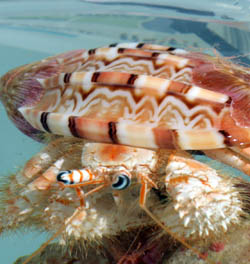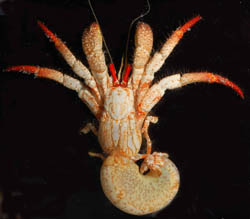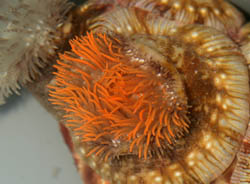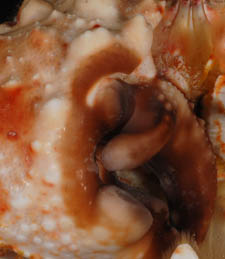Creature
Feature:
Anemone Hermit Crabs
Subphylum: Crustacea
Class: Malacostraca
Order: Decapoda
Infraorder: Anomura
Family: Diogenidae and Paguridae
Click
here to view the anatomy of an Anemone Hermit Crab!
 |
Anemone hermit crabs come in all shapes and sizes. |
One of the most common animals we have been catching in our deep set baited epifauna traps are anemone hermit crabs (Dardanus
brachyops, Dardanus pedunculatus and other species of the genus Dardanus with possibly two new species that we cannot identify. Hermit crabs are crustaceans, like lobsters, and have hard external skeletons and five pairs of legs. They are a very successful animal group with between 1500 and 2000 species around the world. Forty eight species are found in Hawaii, according to a recent report published by the American Fisheries Society, and they occur from the shoreline to depths of 1000 ft or more. Our traps are certainly proving the depth range to be true since we are catching them at 750 feet. Many hermit crabs are nocturnal. They are scavengers and omnivores, and they were likely attracted to our trap because of the dead mackeral the traps were baited with.
 |
In this image you can see what the soft tail of the hermit crab looks like outside the shell.
Photo: Joel Martin |
In the Order Decapoda (shrimp, crabs, lobsters) the shrimp are the
oldest form, and have been around for roughly 300 million years.
Lobsters are more recent and have the same body architecture as a shrimp,
but
are broader and more thickly shelled, and Hermit crabs (roughly
90 -100 million years old) have the same body form as a shrimp but have
a soft
asymmetrical abdomen (like the shrimp’s tail) rotated 90 degrees on its
side. Hermit crabs use the shells of marine snails to protect
these soft parts. The abdomens are adapted to curl into the spiral hole
of a snail
shell and grip the inside with the last pair of legs that are
specifically designed for this purpose. Once inside they are very difficult
to remove,
and can pull their entire body into the opening of the shell
to protect themselves from danger or predators. Many species also have
a specially
adapted oversize front claw, on the opposite side of the body
from the curved tail, that can be used to close off the shell opening
when the
hermit retreats inside. Hermit crabs only leave their shell
when they are changing to another, usually when they have outgrown their
existing
shell or have found another more suitable.
 |
An anemone with orange tentacles attached to a hermit’s shell. |
Anemone
hermit crabs differ from other hermits in that they take defense one step further
by having a commensal (both organisms benefit)
relationship with sea anemones attached to the outside of their shell. Scientists
know that anemone crabs will transfer anemones from one shell to another when
switching shells, but they do not know how the anemones get on a newly inhabited
snail shell. They do know that anemones are not present while the snail occupies
the shell, so it has to have something to do with the crab. One known species
of anemone crab will actually eat the snail to get the shell, the rest will chose
an empty shell, with several strongly attracted to the smell of a dying snail,
like reading the obituary pages to find an apartment in Manhattan, or Honolulu
for that matter. There is even a case of an anemone/crab relationship where there
is no shell involved, but the anemone secretes a shell like material that forms
around the crab.
Certain species of hermits are associated with certain species of anemones, and the most predominant anemone hermit we are finding, the jeweled anemone crab, Dardanus
gemmatus, is typically associated with two species of anemones – Calliactis
polypus and Anthothoe sp. We may also have found a new species of anemone that was attached to the shell of an undescribed hermit crab. When threatened, the anemones are able to eject bright pink stinging threads (acontia) from their bases, and they hover above the crab like a defensive curtain. The tentacles of the anemone sting as well, offering additional defense. The anemone is able to protect itself by withdrawing their tentacles, and closing up into a smooth surface. Once the perceived danger has past they open up again and their tentacles wave in the currents. The crab definitely gets added protection from this arrangement by associating with the stinging anemone, and the anemone may benefit by collecting scraps of food from the crab’s messy eating. The anemones may also benefit from the mobility provided by the crab in the search for places where food is plentiful, and possible defense from predators on anemones.
Anemone crabs are actually host to more than just anemones, and
are a roving community of organisms. The jeweled anemone crab has a
flatworm (Stylochoplana
inquilinia) and an amphipod (Elasmopus calliactis) associated
with it, and on this trip a possible new species of barnacle was found on
an anemone crab shell.
 |
The specially adapted right claw of a box crab. Photo: Joel Martin |
Anemone crabs are
eaten by several fish that predate upon crustaceans, such as puffer and triggerfish,
as well as other animals that eat crustaceans. Hermits may also be predated upon
by a particular species of crab, the box crabs, family Callipidae, that have
a special adaptation on one of their claws that allows them to chip open the
shell of marine snails in the same fashion as a can opener. If a hermit has the
bad fortune of being in one of these shells they may be eaten by the attacking
box crab.
References:
Hoover,
John, “Hawaii’s Sea Creatures, A Guide to Hawaii’s Marine Invertebrates”
Personal
conversations with Joel Martin, Gustav Paulay, Sea McKeon,
and Cory Pittman
*All images and information from French Frigate Shoals are provided
courtesy of the Northwestern Hawaiian Islands Marine National Monument,
Hawaiian Islands National Wildlife Refuge, the Northwestern Hawaiian
Islands State Marine Refuge, and NOAA's Pacific Islands Fisheries
Science Center in accordance with permit numbers NWHIMNM-2006-015,
2006-01, 2006-017, and DLNR.NWHI06R021 and associated amendments.
Click
on one of the following areas to follow the expedition.
Ship
Logs:
Day-by-day
activities of the ship: what research is being done that
day, what the weather is like, what's for dinner, etc.
Journals:
Daily
or semi-daily personal journal entries by the particpants
in the expedition. These journals do not necessarily reflect
the positions of any of the agencies connected with this
project.
Interviews:
Interviews with expedition participants, scientists,
vessel crew, educators, etc.
Features:
Highlights or special information such as interesting
discoveries or related research.